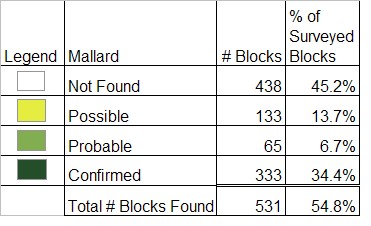Find a Bird - BBA1
Breeding Bird Atlas 1 Species Accounts
Mallard
Anas platyrhynchos
Egg Dates
April 1 to late July
Number of Broods
one; may re-lay if first attempt fails.

Just about everybody knows the drake Mallard with his distinctive plumage, but his brown mate frequently goes unnamed, although both sexes are the ducks fed by park visitors. Mallards breed throughout the Northern Hemisphere and are now widespread and common in the Commonwealth. However, accounts by early ornithologists indicate that the Mallard was rare in Massachusetts prior to the 1930s. This population increase has had a negative impact on the American Black Duck (see account for that species).
Mallards, like Canada Geese, were brought here by waterfowlers who used them as live decoys or call ducks until that practice was outlawed in 1935. The liberated birds adapted readily to the lakes and ponds of Massachusetts, especially in areas where they were fed. There is some evidence that Mallards also have expanded their range eastward from the Midwest in response to the forest clearing and pond construction that occurred during the past 200 years. Numbers have risen steadily since 1950, with a sharper increase after 1970.
Pair formation in Mallards is accomplished through a series of ritualized displays. Females quack and make several special vocalizations when they are feeding or communicating with ducklings. Males make similar but coarser sounds. While there is some migration of Mallards into our state in the spring, the bulk of the birds are year-round residents that winter at some 200 sites where people feed them. These birds move into surrounding areas to nest. True cosmopolites, Mallards utilize any number of nesting sites from fields, wooded edges, Muskrat houses, lidless Wood Duck boxes, and tree crotches to grape arbors and cemeteries. The surrounding habitat may be Beaver ponds, deep marshes, meandering streams, agricultural areas, suburbs, city parks, or coastal salt marshes. It is this adaptability that has made the Mallard so successful.
Mallard nesting begins in early April. The hen makes a nest bowl and adds fragments of nearby vegetation, finishing the structure with down as the clutch nears completion. The average number of eggs is nine, but there is much variability. Early nesters tend to have larger clutches than later nesters. Incubation takes about 28 days, and the first broods generally appear after May 10, slightly later than the first black duck broods. Downy young are encountered through mid-August, as nesting hens hatch late clutches. The hen leads the ducklings to water as soon as their downy fluff is dry. There they feed on invertebrates, switching to plant food as they grow. Broods of park Mallards in Massachusetts consist of one to eleven ducklings, with four to six most common. Juveniles can fly from 49 to 60 days after hatching.
In late summer, young and old tend to aggregate on ponds and lakes. In eastern Massachusetts, drakes frequently move into urban parks to undergo their annual molts. Females and juveniles also tend to head for these sites in the fall. A few birds go south, but not very far, and not many Massachusetts Mallards winter farther south than New Jersey. Park flocks also attract wild migrants from eastern Canada. It appears that some Mallards from the Midwest and far West migrate east in the fall. These birds are almost exclusively males.
Map Legend and Data Summary
Atlas 1 data collected from 1975-1979


Note: common and widespread in areas of freshwater ponds and marshes, including city and town parks
H. W. Heusmann



